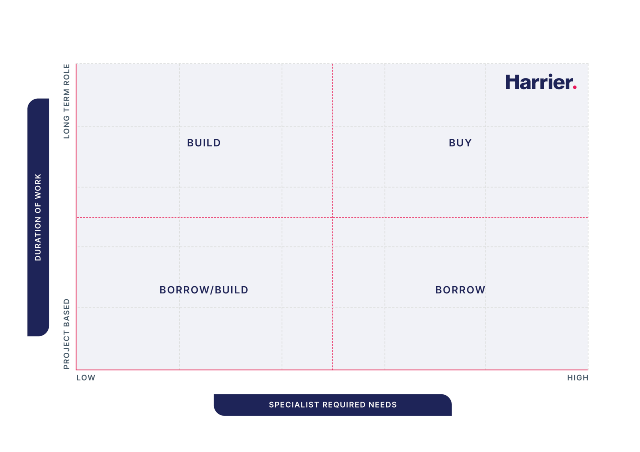Build, Buy or Borrow
- Gain an understanding of the 3 primary approaches to Talent Acquisition – building talent internally, buying talent from the outside, and borrowing talent through temporary or contract arrangements.
- Learn the benefits and disadvantages associated with building, buying or borrowing talent and when you should apply them to your business
- Understand how to align your talent acquisition strategy with your company's strategic objectives, budget constraints, and urgency of talent needs.

In the constantly evolving world of talent strategy and recruitment, businesses often grapple with a critical decision: should they build, buy, or borrow talent? Each approach has its unique benefits and disadvantages, and understanding these can empower organisations to make strategic decisions that align with their goals and resources. This article delves into these three strategies, offering insights to help you decide the best course for your company.
Building Talent Internally
What is it?
Building talent involves investing in the development and upskilling of existing employees. This strategy focuses on nurturing and enhancing the skills of your current workforce to meet future business needs.
Benefits:
Cultural Alignment: Employees already acquainted with your company's culture and values contribute to a cohesive work environment.
Employee Engagement: Investment in employee development often leads to higher job satisfaction and loyalty.
Cost-Effectiveness: Generally, it's more cost-effective to train existing employees than to acquire new ones, especially when considering recruitment and onboarding expenses.
Disadvantages:
Time-Consuming: Skill development is a long-term investment and may not be ideal for immediate business needs.
Resource Intensive: Requires significant resources for training and development programs.
Limited by Current Talent Pool: Your current employees may not have the foundational skills or potential required for certain roles.
When to Consider:
Build when you have a strong internal talent pool and the time to nurture these skills.
Buying Talent
What is it?
Buying talent refers to recruiting skilled professionals from outside the organisation. This strategy is about acquiring individuals who already possess the desired skills and experience.
Benefits:
Immediate Impact: New hires can often contribute immediately, bringing fresh perspectives and skills.
Access to a Wider Talent Pool: Opens up opportunities to tap into a broader range of skills and experiences.
Strategic Skill Acquisition: Allows for targeted hiring to fill specific, immediate gaps in your workforce.
Disadvantages:
Higher Costs: Recruitment, relocation, and higher salary expectations make this an expensive option.
Cultural Fit Risk: New hires might not seamlessly integrate into your existing company culture.
Potential for Turnover: External hires may have less loyalty to the company and a higher tendency to leave.
When to Consider:
Buy when you need specific skills quickly, especially for roles that are critical to business operations or where the required skill set is not present internally.
Borrowing Talent
What is it?
Borrowing talent involves leveraging external resources, such as contractors, freelancers, or temporary staff, to meet short-term business objectives.
Benefits:
Flexibility: Offers the ability to scale your workforce up or down based on business needs.
Specialised Skills for Specific Projects: Ideal for project-based work requiring specialised skills not available in-house.
Reduced Long-Term Commitment: Less financial commitment in terms of benefits and long-term salaries.
Disadvantages:
Less Control: Borrowed talent may divide their focus across multiple clients.
Integration Challenges: Temporary staff may not fully integrate into your team or understand your company culture.
Continuity Issues: Reliance on external talent can lead to continuity issues in long-term projects.
When to Consider:
Borrow when you need specialised skills for short-term projects, or when you require workforce flexibility to manage fluctuating demands.

Balancing the Trio
No single strategy is a one-size-fits-all solution. The choice between building, buying, or borrowing talent should be driven by your specific business context, including your strategic objectives, budget constraints, and the urgency of your talent needs.
For instance, if you are planning for long-term growth in an area where you already have some foundational skills, building might be your best option. On the other hand, buying is more appropriate for immediate, high-impact roles where specific skills are lacking internally. Borrowing, meanwhile, offers a solution for project-based work or seasonal fluctuations in demand.
Each recruitment strategy – build, buy, or borrow – has its place in the talent acquisition and development landscape. The key is to understand your organisation's immediate and long-term needs, the market's talent availability, and your capacity to invest in development. By weighing the advantages and disadvantages of each approach, you can make informed decisions that will drive your organisation's success in an ever-changing business environment. Remember, the most effective talent strategy often involves a balanced combination of building, buying, and borrowing.

